Instruction Manual
An instruction manual is included in your JB-3 Leg Bag Emptying Kit, which is the same as this online manual.
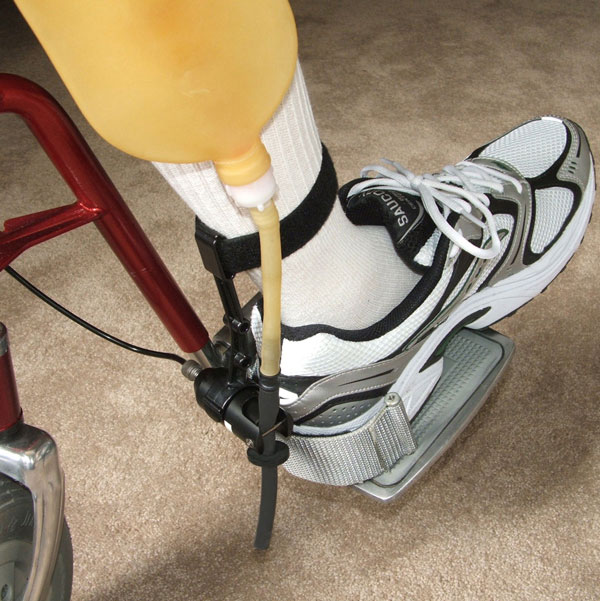
Leg Bag Emptier
Owner's Manual
Victor Mobility, LLC
CONGRATULATIONS!
You are about to regain the freedom to empty your leg bag any time you desire. This owner’s manual will take you through the 5 simple steps required to set up and maintain your JB-3 Leg Bag Emptier for years of trouble-free use.
Table of Contents
- Warranty & Serial Number
- Kit Contents & Description
- Setup
- Adjusting Clamp Force
- Helpful Tips
- More Methodes toAssist in Activation
- Troubleshooting
Warranty
Coverage:
The JB-3 Leg Bag Emptier is covered by a 1-Year Manufacturer’s Warranty.
This warranty covers any failure of the JB-3 product due to manufacturing errors and/or defects. (Read more about our Warranty.)
This warranty also covers any performance failure of the JB-3 product when used in accordance with the supplied instructions and Black Drain Tubing. This warranty does not cover damages or defects relating to misuse, abuse, negligence, normal wear and tear, alterations, exposure to the elements, acts of God, improper installation, storage or handling. Any consequential damages or losses directly or indirectly related to failure of the JB-3 product will NOT be covered. In no event shall our liability exceed the cost of the goods.
Replacement Terms:
We will, at our discretion, either repair the defect or replace the product upon receiving the failed item and determining that the failure falls within the coverage conditions expressed in this warranty.
To receive in-warranty service, please contact Victor Mobility LLC listed on the back of this instruction manual. A proof of purchase such as an invoice or receipt will be necessary.
This warranty is not transferable.
Kit Contents
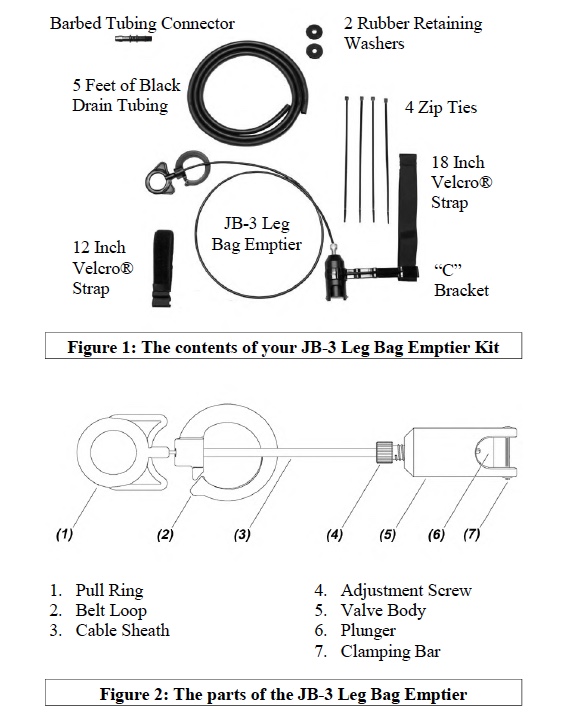
Setup
Warning: The JB-3 Leg Bag Emptier is designed to work with the supplied Black Drain Tubing and is warranted for performance only with the supplied tubing.
1. Cut and Attach Drain Tube:

Take the Barbed Tubing Connector (with Black Drain Tubing attached) from the package and put it next to your current leg bag tubing to determine where you should cut your current tubing. Make sure that the Black Drain Tubing is long enough to extend past the foot rest. You will also want to cut your current leg bag tubing so there is enough to roll onto the Barbed Tubing Connector.
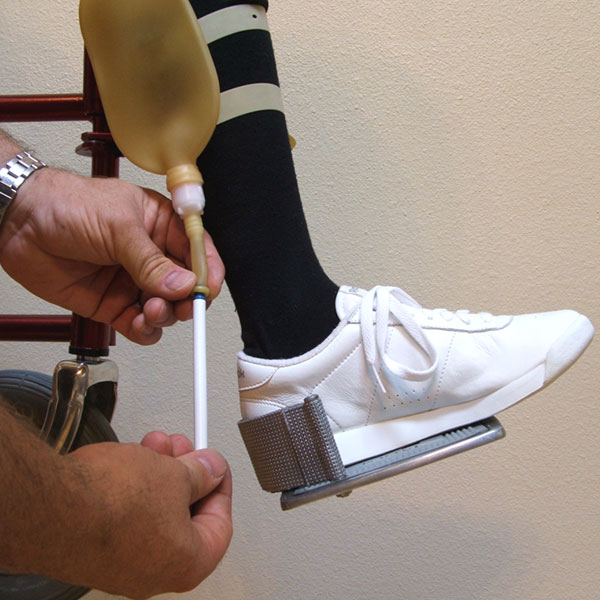
After cutting your current leg bag tubing to the correct length, attach the Barbed Tubing Connector with the Black Drain Tubing.
An easy way to do this is by inserting a pen or pencil into your current leg bag tubing about 1 inch and rolling the tubing onto itself until the pen or pencil is no longer inside the tubing.
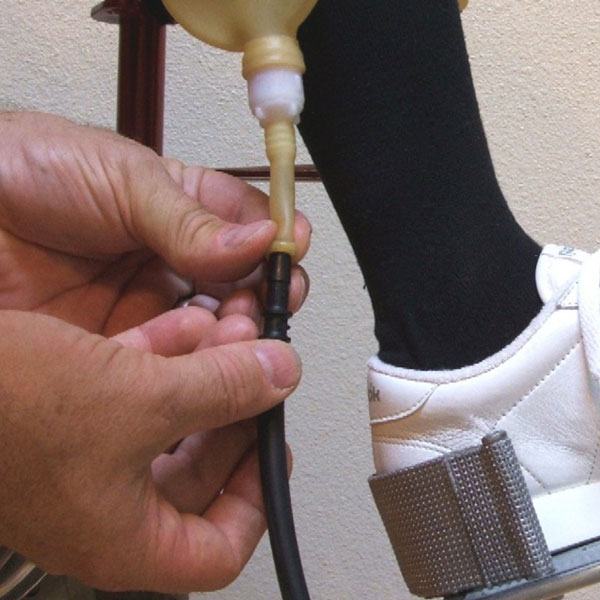
While holding the rolled-up tubing, place the Barbed Tubing Connector up to this rolled-up tubing and unroll it onto the Barbed Tubing Connector.
NOTE: The Barbed Tubing Connector is not required. In some cases you may want to connect the Black Drain Tubing directly to the petcock valve of your leg bag.
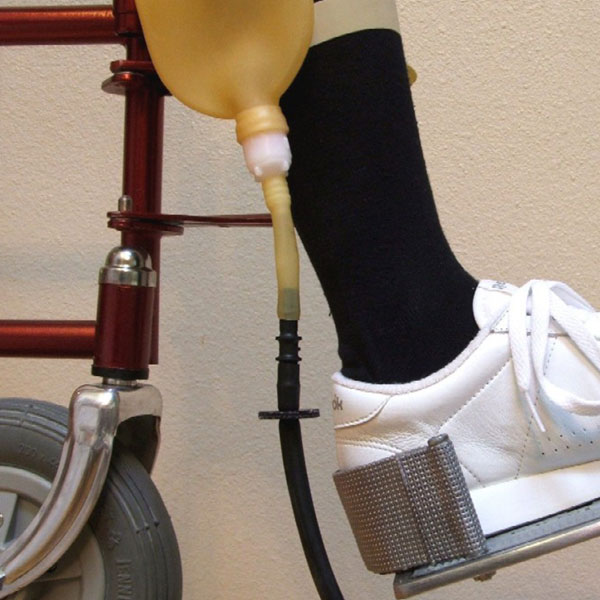
The drain tubing should look something like this.
The first of two Rubber Retaining Washers should be put on now. Just put the Black Drain Tubing through the hole in the Rubber Retaining Washer and slide it up a few inches.
2. Insert Black Drain Tubing in Clamp Area
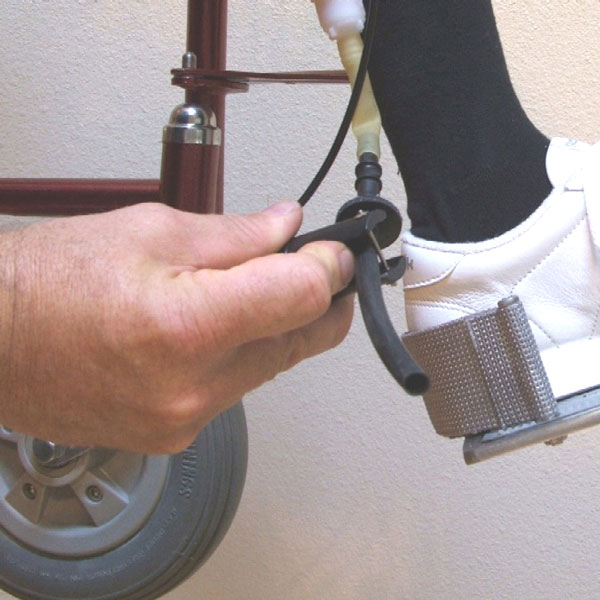
Press on the Plunger with your finger (Figure 2, Item 6) and insert the Black Drain Tubing between the Clamping Bar (Figure 2, Item 7) and the Plunger.
Let the Plunger snap into place. Now is also a good time to see if the Plunger moves freely without sticking. If it does seem sticky, please see the “Troubleshooting” section (Page 13) to diagnose and correct the problem.
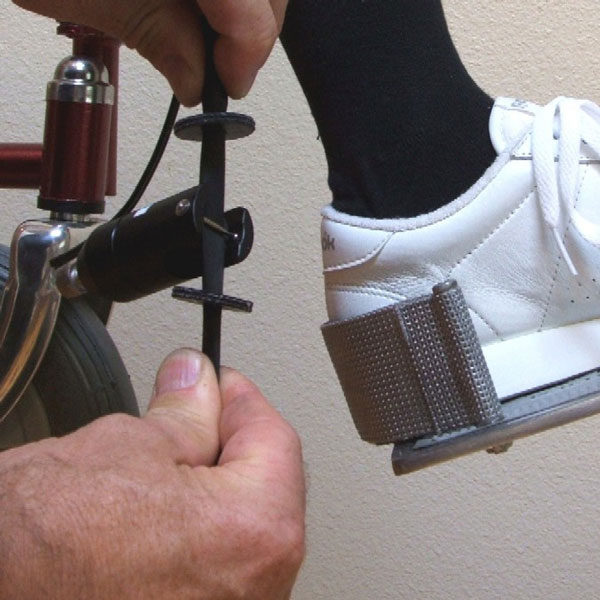
Slide on the second Rubber Retaining Washer.
To remove crimping from inside the Rubber Retaining Washers and any folds in the clamping area, stretch the Black Drain Tubing using both hands. This procedure will ensure an easy reliable flow of urine.
3. Position the "C" Bracket

It is important when installing the “C” Bracket that you slide it from the tapered end of the Valve Body up to where it clicks into place on the groove of the Valve Body
Removing the “C” Bracket should be just the reverse. Doing it this way reduces the stress on the plastic and helps prevent the “C” Bracket from breaking.
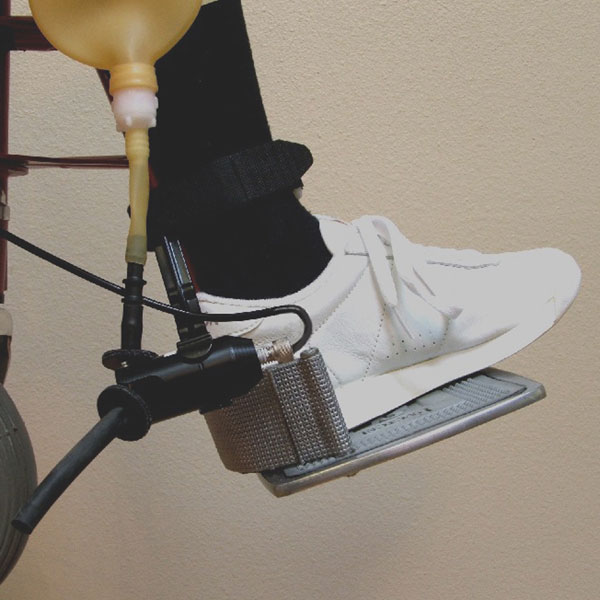
Make sure when you position the “C” Bracket that the cable is not doubling back. This is an example of the cable doubling back on itself.
Tight corners or loops cause resistance that can result in dripping and make activation much harder. Re-routing the Cable or turning the Valve Body around in the “C” Bracket should correct the problem.

Checklist for a correctly-installed JB-3 Leg Bag Emptier:
- No tubing is kinked.
- Cable has no sharp bends.
- Retaining Washers are installed.
- Black Drain Tubing positioned to drain away from footrest.
- The valve on the leg bag is open.
- There is no dripping
- The tilting mechanism of the wheelchair doesn’t pull or crush the cable.

An alternate installation allows attaching the “C” Bracket to the foot-rest strut using the supplied Zip Ties. No damage is done to the wheelchair and the Zip Ties can be easily cut for removal.
Some people prefer not to use the “C” Bracket at all and only use the Rubber Retaining Washers to hold the valve in place.
4. Attaching the Belt Loop
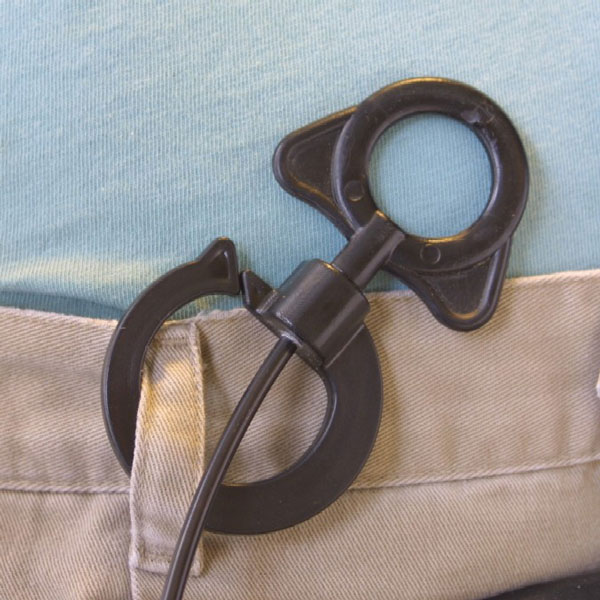
There are a number of ways in which the Belt Loop (Figure 2, Item 2) can be attached. The Belt Loop allows you to hook it to almost anything, including the loop on your pants. The Cable (Figure 2, Item 3) can run down either inside or outside the pants. Be very careful not to allow the Cable to be situated so that it may cause tissue irritation if worn inside the pants.
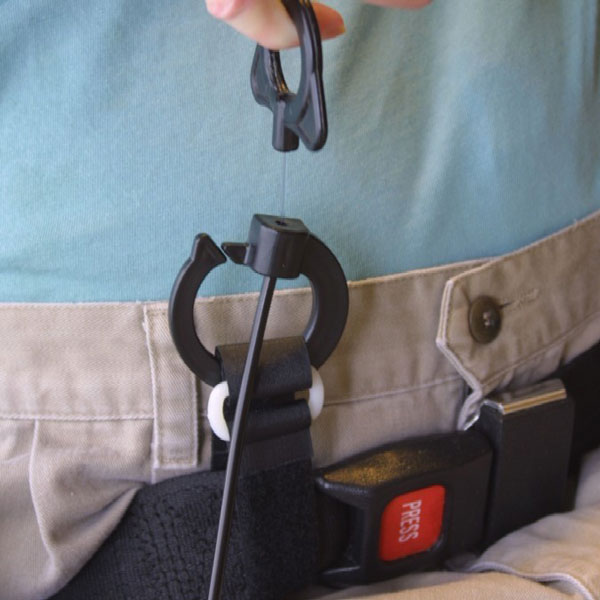
If you are not wearing clothing that has a belt or a belt loop, the Belt Loop (Figure 2, Item 2) can be attached to the wheelchair’s safety belt.
If the wheelchair safety belt is too thick or wide to be used , then try using the 12 inch Velcro) Strap around the safety belt as shown here.
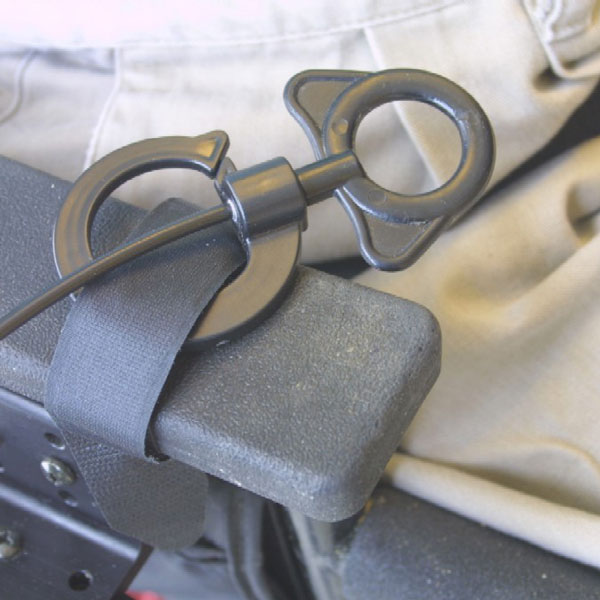
To attach the Belt Loop to the wheelchair, you can use the supplied Velcro Strap around the arm of the wheelchair.
If you would like the Belt Loop to be attached to something that is more than 1/4 inch thick, use the Velcro(R) Strap around that object, then attach the Belt Loop to the Velcro(R) Strap as shown here. A Zip Tie could also be used in this way.

Some people prefer to attach the Belt Loop (Figure 2, Item 2) to the lower leg brace of the wheelchair.
In this case a shorter Cable (Figure 2, Item 3) was ordered. If you think you would benefit from a shorter or longer Cable contact customer service.
5. Verifying a Correct Installation
Position the Black Drain Tubing over an appropriate receptacle and pull on the Finger Loop (Figure 2, Item 1).
The JB-3 Leg Bag Emptier is designed to drain a 750 ml. leg bag in under 30 seconds, with less than 3 lbs. of pulling force.
Let a small amount of urine drain, then release the Finger Loop. Wait 30 seconds. If no urine drips, then the JB-3 Leg Bag Emptier is correctly installed.
It is normal to have 1 drip of residual urine after you release the Finger Loop. Several drips within 30 seconds means there are adjustments that need to be made.
Go to the “Troubleshooting” section to determine what to do next. It’s best to try this testing procedure 2 to 3 times to make sure there are no problems when you first install the JB-3 Leg Bag Emptier
The following pages contain general information that will help keep your JB-3 Leg Bag Emptier in good working order for years of trouble free use.
Putting Clamping Force to Factory Setting
NOTE: The Adjustment Screw and Cable Sheath is an assembly (Figure 2, Item 3 and 4). In order to turn the Adjustment Screw without causing the Cable Sheath to become detached, the Cable Sheath will have to be turned with the Adjustment Screw.
NOTE: No adjustment of the clamping force should be necessary when you receive your JB-3 Leg Bag Emptier.
The JB-3’s clamping force is set at the factory for optimal clamping force with the supplied Black Drain Tubing. The following information is most commonly used after the Adjustment Screw/Cable Sheath Assembly has been removed to clean the Valve Body of debris.
To put the clamping force of the JB-3 Leg Bag Emptier in the approximate factory setting as shown in Figure 17, install the Adjustment Screw/Cable Sheath Assembly by screwing it into the Valve Body (Figure 2 item 5) as far as it will go. Now, unscrew the Adjustment Screw/Cable Sheath Assembly 3 1/2 turns. Follow the instructions “Adjusting Clamping Force” (Page 10) if further adjustments are necessary.
Adjusting Clamping Force

The JB-3 Leg Bag Emptier has been designed to have an adjustable clamping force so that it will reliably drain and retain urine in a leg bag with minimal activation strength required.
Figure 17 represents how the Adjustment Screw looks when it is in the approximate factory setting, while Figure 18 represents how the Adjustment Screw looks when maximum clamping force is applied.
Turn the Adjustment Screw (Figure 2, Item 4) clockwise to apply more clamping force. Turn the Adjustment Screw counter clockwise to reduce clamping force.
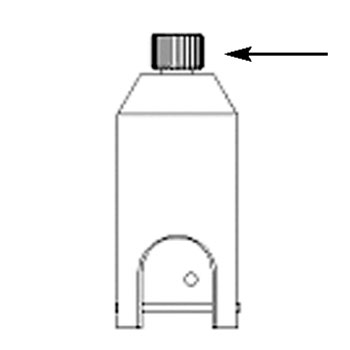
WARNING: Additional clamping force also puts additional stress on the Pull Ring (Figure 2, item 1), Belt Loop (Figure 2, Item 2) and Cable (Figure 2, item 3).
Adjust in 1/2 turn increments and test for leaking. When making adjustments it is best to put a receptacle under the drain tube to catch any drippings. To help avoid excessive stress, it’s recommended that the clamping force is not increased more than 2 complete turns past the factory setting.
NOTE: If there is mechanical failure such that activation with the Finger Loop isn’t possible, an attendant can press the plunger back with their finger to drain the leg bag.
Helpful Tips
- Your JB-3 Leg Bag Emptier requires almost no maintenance. Periodic cleaning of the Valve Body and Plunger in warm soapy water is all that is needed to keep the valve functioning properly. See “Cleaning the Clamping Area of the Valve Body” in the “Troubleshooting” section (Page 14).
- The only adjustment required is to the clamping force by use of the Adjustment Screw/Cable Sheath Assembly (Figure 2, Items 3 and 4) . If there is still dripping after tightening the clamping force 2 full turns, then there is something else wrong that is causing the dripping and you should refer to the “Troubleshooting” section (Page 13).
- Often a simple slight pull of the Black Drain Tubing to straighten and align it in the clamping area is all that is required to stop minor leaks.
- The JB-3 Leg Bag Emptier is made of Delrin, polycarbonate, nylon, and stainless steel. The plastics were chosen for their lightweight and chemical resistance properties. Be very careful not to damage the plastic components of your JB-3 Leg Bag Emptier. Screwdrivers or pliers can mar or damage the plastic components and lead to failures.
- Do not put the Cable under the seat or where the tilting mechanism may damage it. If the Cable is crushed, the result is resistance when being activated and leaking when released.
- Make sure the drain tubing is not crimped above the Valve Body. Crimped tubing can cause a significant increase in the time it takes to drain your bag.
- To prevent accidental breakage, please don’t force the Belt Loop onto objects wider than ¼ of an inch. If you need to attach the Belt Loop around objects that are thicker than ¼ of an inch, like part of your wheelchair frame, use the supplied Velcro® Strap to wrap around the wheelchair frame, then slip the Belt Loop onto the Velcro® Strap. Refer to Figures 15 and 16.
- To help prevent the “C” Bracket from breaking, it is best to slip the “C” Bracket onto the Valve Body from the tapered end, and then slide it up until it clicks into place. To remove the “C” Bracket, reverse the procedure. This eliminates excessive spreading of the plastic.
More Methods to Assist in Activation
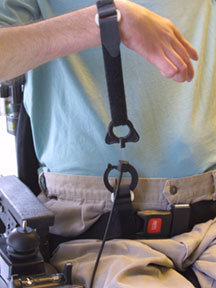
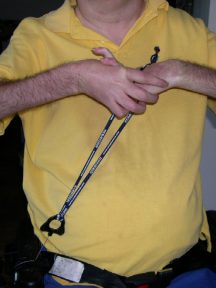

Troubleshooting
Pull Ring is harder to pull than usual, or dripping is occurring—
- Inspect the Cable (Figure 2, Item 3) to ensure it is not damaged or crushed. If it is hard to tell if there is binding, then check it after removing the JB-3 Leg Bag Emptier from the wheelchair.
- Do not put loops in the Cable (Figure 2, Item 3) to take up excess length. Loops cause binding and will cause dripping. The straighter the Cable, the better the JB-3 Leg Bag Emptier will perform.
- In many cases dripping is caused by dried urine residue and dirt in the Plunger and Clamping Bar area. Verify that the Plunger (Figure 2, Item 6) pushes into the Valve Body (Figure 2, Item 5) easily with your finger. If there is binding, clean the Valve Body and Plunger as described in “Cleaning the Clamping Area of the Valve Body” (Page 14).
- Verify that the Plunger (Figure 2, Item 6) comes in complete contact with the Clamping Bar (Figure 2, Item 7). To do this, remove the Black Drain Tubing from the clamping area. While the Plunger is resting against the Clamping Bar, hold the Valve Body up to a bright light and see if there is any light that is visible between the Plunger and the Clamping Bar. If there is light between the two, follow the process “Cleaning the Clamping Area of the Valve Body” (Page 14).
- Verify Clamping Bar (Figure 2, Item 7) is securely in place and does not easily move.
- Make sure the Cable (Figure 2, Item 3) is not doubled back on itself. See Figure 10 for a picture and more complete explanation. If the Cable is doubling back, reposition the Cable or turn the Valve Body around in the “C” Bracket to correct the alignment.
- If leaking persists after all steps above are taken, then see “Adjusting Clamping Force” (Page 10).
- Verify that the tilting mechanism is not affecting the cable by crushing or stretching it when tilting back.
Urine takes a long time to drain—
- Inspect the tubing between the leg bag and the Valve Body (Figure 2, Item 5) for crimping. Using the “C” Bracket usually prevents the Valve Body from moving into extraordinary positions that may cause crimping of the drain hose.
- Verify that the petcock or twist valve on the leg bag itself is fully opened.
- Make sure there isn’t a crimp inside the Rubber Retaining Washer. If there is a crimp in the Rubber Retaining Washer, remove the crimp as shown in Figure 8. Sometimes expanding the distance between the Retaining Washers will help prevent crimping.
Cleaning the Clamping Area of the Valve Body —
DO NOT PUT YOUR JB-3 LEG BAG EMPTIER INTO THE WASHING MACHINE OR DISHWASHER!
- Soak the Valve Body (Figure 2, Item 5) in hot soapy water from the tap. Press the Plunger (Figure 2, Item 6) with your finger multiple times while it is under water. This will assist in flushing any debris from within the Valve Body. NOTE: Try not to submerge the Cable Sheath (Figure 2, Item 3). Water will add resistance if water gets inside the Cable Sheath.
- After allowing to soak for an hour, thoroughly clean the Valve Body (Figure 2, item 5) and Plunger (Figure 2, Item 6) and around the Clamping Bar (figure 2, item 7) with a rag, or old toothbrush. Turn the plunger with your fingers to clean all sides.
- Drain the water out, and rinse thoroughly. Check to see that the Plunger (Figure 2, Item 6) slides smoothly and presses against the Clamping Bar (Figure 2, Item 7). When held up to a bright light, there should be no light showing between the Clamping Bar and the Plunger when they are in contact with each other.
- Allow the JB-3 to drip dry over night.